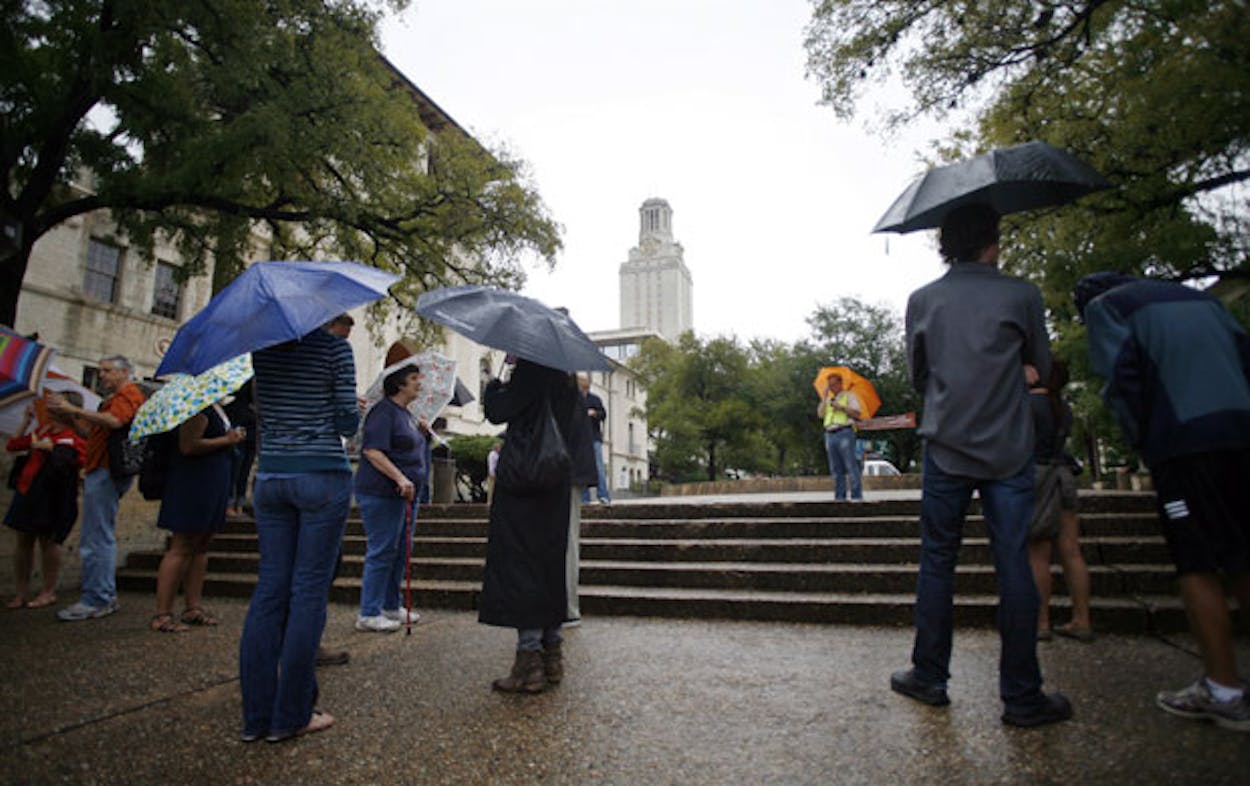Tens of thousands of UT students and faculty filed out of classrooms and dorms Friday morning after a bomb threat prompted university officials to evacuate all campus buildings.
“Immediately evacuate all buildings on campus get as far away from the buildings as possible. Further information to come,” the alert said.
Peggy Fikac of the San Antonio Express-News described the scene this way: “As alarms were sounded, people streamed off the rain-soaked campus to huddle under umbrellas and duck into nearby restaurants and shops while the massive campus was inspected.”
The evacuation seemed to be marked by confusion, not terror. “It was calm but nobody knew what was going on,” Tania Lara, a graduate student at the Lyndon B. Johnson School of Public Affairs, told the AP. “No one was yelling `get out of here’ or anything like that.” Faculty recalled getting hung up in traffic trying to leave their parking garages.
Many questioned the timing of the evacuation. The university received a phone call at 8:35 a.m. warning that explosions would happen all over campus in ninety minutes, but an evacuation was only ordered at 9:50 a.m., 75 minutes later and only fifteen minutes before the bombs would have gone off. The university sent a text message to 69,000 people telling them to leave campus buildings.
At a noon press conference, UT President Bill Powers and UT Campus Police Chief Robert Dahlstrom, were peppered with questions about the timing.
“The first thing we do is evaluate the threat. It’s easy to make a phone call,” Powers explained. “If the threat had been for something to go off in five minutes, then you don’t have the time to evaluate, you just have to pull the switch.”
The school has also been criticized for releasing a statement during the hubbub that described the caller as “a male with a Middle Eastern accent” who claimed he was affiliated with Al Qaeda, the Dallas Morning News reported.
Assistant Professor Snehal Shingavi told the Daily Texan he feared that Muslim students could be targeted because the university released that information. He invited interested students to sit in on his class about Islamophobia.
“The problem with that particular fact in a post-911 world is that it produces a narrative of what was going on in advance of knowing the full facts of what happened. … which in this country can become inflammatory rather quickly,” Shingavi told Fikac.
University spokesperson Rhonda Weldon told Fikac that the school has “come to realize that including that has caused some pain to members of our community, and it raised some legitimate fears about propagating some stereotypes.”
At the Daily Texan, Mary Ellen Knewtson spoke to an FBI spokesman who said the agency is investigating whether Friday’s bomb threats at several universities around the country could be connected. “One of the many things we’re looking into is the possible connection to the other hoax calls,” Erik Vasys said.
UT was one of four schools across the country to receive bomb threats on Friday. Two of those schools, North Dakota State University and Hiram College, in Ohio, ordered evacuations, clearing 20,000 and 1,300 people off campus respectively, Knewston reported. The fourth school, Indiana’s Valparaiso University, decided not to order an evacuation after discovering graffiti that warned that “dangerous and criminal” activity would occur on campus at 11:15 a.m. Friday.







